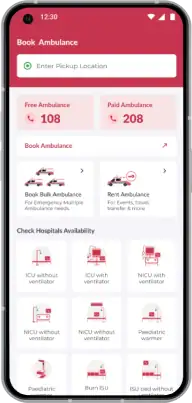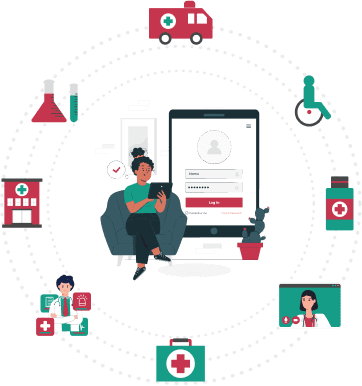Pediatric emergencies present a unique set of challenges that require specialized care and attention. Children's bodies are still developing and their medical needs differ significantly from those of adults. In emergency situations, ambulance services play a crucial role in ensuring the safety and well-being of young patients. This blog explores how ambulance services are tailored to address the distinct requirements of pediatric emergencies, highlighting the importance of specialized training, equipment and communication.
Understanding the Unique Needs of Pediatric Patients
Physiological Differences:
Children's bodies differ markedly from adults in terms of physiology, necessitating specialized care during emergencies. Vital signs such as heart rate, respiratory rate and blood pressure exhibit age-specific variations, making precise assessment crucial for accurate diagnosis. Moreover, pediatric patients respond differently to medications, requiring precise adjustments in drug dosages to avoid complications. Ambulance services are tasked with the responsibility of recognizing and accommodating these distinctions, ensuring tailored medical interventions that account for the unique physiological characteristics of children. By acknowledging and accommodating these differences, ambulance professionals play a pivotal role in safeguarding the well-being of pediatric patients in critical situations.
Emotional and Psychological Considerations:
In the midst of pediatric emergencies, the impact reverberates not only through the young patients but also deeply affects their parents. The distressing nature of such situations can magnify the anxiety and fear experienced by both children and their caregivers. Acknowledging this, ambulance crews undergo specialized training that extends beyond medical expertise. They are equipped with the skills to offer crucial emotional support, serving as calming anchors during the storm of uncertainty. Through compassionate communication and a soothing behavior, these professionals create a safe space where children and parents alike can find reassurance amid the chaos. By attending to both the medical needs and emotional well-being of their young patients and families, ambulance crews exemplify the holistic care required in these challenging moments.
Specialized Pediatric Training for Ambulance Crews
Pediatric Advanced Life Support (PALS) Training:
Ambulance personnel undergo intensive training in pediatric advanced life support (PALS), enabling them to adeptly handle critical scenarios like cardiac arrest, respiratory distress and shock in children. This specialized training equips them with a deep understanding of pediatric anatomy, physiology and medical interventions tailored to young patients. They learn to accurately assess and respond to pediatric emergencies, administer age-appropriate medications and employ advanced techniques such as airway management and chest compressions. By honing these skills, ambulance personnel ensure that they can provide swift and effective care during high-stress situations involving children. PALS training empowers these professionals to be confident, competent first responders capable of making a significant difference in the lives of pediatric patients facing life-threatening conditions.
Effective Communication with Children:
In pediatric emergencies, effective communication with children demands a distinct approach. Ambulance crews are adept at employing language that suits the child's age, ensuring understanding and reducing anxiety. Their composed demeanor and reassuring attitude create a sense of calm, fostering trust between the young patients and the medical team. This specialized approach not only facilitates clear communication but also helps alleviate the apprehension that often accompanies emergencies, enabling ambulance personnel to provide the best possible care to their young charges.
Pediatric-Friendly Ambulance Equipment
Child-Sized Medical Devices:
In pediatric emergencies, ambulance services are well-equipped with specialized tools tailored to the unique needs of young patients. Child-sized airway management tools, defibrillator pads, and blood pressure cuffs are among the essential equipment carried. These specialized tools are designed to ensure precise measurements and effective treatment delivery. Child-sized airway management tools guarantee unobstructed breathing, defibrillator pads are appropriately sized for children's chests and blood pressure cuffs provide accurate readings for proper diagnosis. By having these dedicated tools on hand, ambulance services can swiftly and accurately address pediatric medical situations, providing the highest level of care when every second counts.
Secure Child Restraints:
In order to guarantee the safety of pediatric patients while in transit, ambulances are outfitted with specialized child restraints designed for varying age brackets. These restraints serve the crucial purpose of restraining movement, effectively mitigating the potential for additional injuries. By securing young patients in age-appropriate restraints, ambulance services significantly enhance the protective measures in place during transportation. This careful consideration of child-specific safety measures underscores the commitment of ambulance services to provide the highest level of care, particularly tailored to the unique needs of pediatric patients.
Child-Centric Approach to Medical Care
Distraction Techniques:
Ambulance crews possess the expertise to employ ingenious distraction techniques, including the use of toys, games and storytelling, to effectively shift the focus of young patients away from potentially distressing medical procedures. By engaging children's imaginations and creating a more comforting environment, these strategies significantly diminish feelings of anxiety and fear that often accompany medical interventions. These compassionate approaches not only aid in completing necessary procedures more smoothly but also contribute to a more positive and reassuring experience for both the young patients and their concerned families.
Pain Management:
In pediatric cases, implementing precise pain management approaches is imperative. Ambulance professionals are adeptly trained to administer pain relief medications that are specifically suited for children. This ensures that discomfort is alleviated effectively. What's more, these experts vigilantly monitor the young patients' reactions to the medication, ensuring their safety and comfort throughout the process. This combination of tailored pain relief and vigilant monitoring underscores the commitment of ambulance personnel to provide optimal care for pediatric patients, minimizing distress and promoting their overall well-being.
Also Read: MedCab: India's Fastest Ambulance Service
Collaboration with Pediatric Hospitals
Pre-Designated Pediatric Centers:
Ambulance services often have agreements with pediatric hospitals, ensuring that pediatric patients are transported to facilities equipped to handle their specific medical needs.
Communication with Hospital Staff:
Ambulance crews maintain open communication with hospital staff during transit, providing them with crucial information about the patient's condition and any interventions performed en route.
Preventing Pediatric Emergencies
Community Education:
Ambulance services engage in community education programs to raise awareness about child safety measures, accident prevention and basic first aid for parents and caregivers.
School and Daycare Partnerships:
Collaboration with schools and daycare centers enables ambulance services to participate in emergency preparedness drills and offer training to staff on pediatric first aid.
Conclusion
Pediatric emergencies demand a specialized approach that acknowledges the unique physical, emotional and psychological needs of young patients. Children's bodies and minds require careful consideration in emergency situations, requiring expertise that goes beyond standard care protocols. Ambulance services are at the forefront of providing critical care tailored to children, with a deep understanding of the differences that come with treating pediatric patients. Ambulance Services play a crucial role in Pediatric Emergencies. This includes not only specialized training and equipment but also the ability to establish compassionate communication that reassures both the child and their caregivers. By understanding and addressing these unique needs, ambulance services play an essential role in ensuring the well-being of our most vulnerable population – our children. Their commitment to delivering effective and sensitive care during these critical moments significantly contributes to the safety and health of young patients.






